This is a Clarus MS-35 camera made by the Clarus Camera Manufacturing Co. based out of Minneapolis, MN. This was the first and only camera made by Clarus and was sold between the years of 1946 and 1952. The Clarus MS-35 was an ambitious 35mm rangefinder that bore a striking resemblance to the Leica rangefinder of the same era, and included several competitive features such as a coupled rangefinder, interchangeable lens mount, and top 1/1000 second focal plane shutter. The camera has a solid all metal body, and typically came equipped with a very capable Wollensak f/2.8 lens. Early Clarus models were notorious for failing even when new. Despite several improvements to the design by 1948, the camera could not escape it’s extremely poor reputation. As a result, this would be the only model ever made by Clarus, and after it’s discontinuation in 1952, the company closed it’s doors, never to be heard from again.
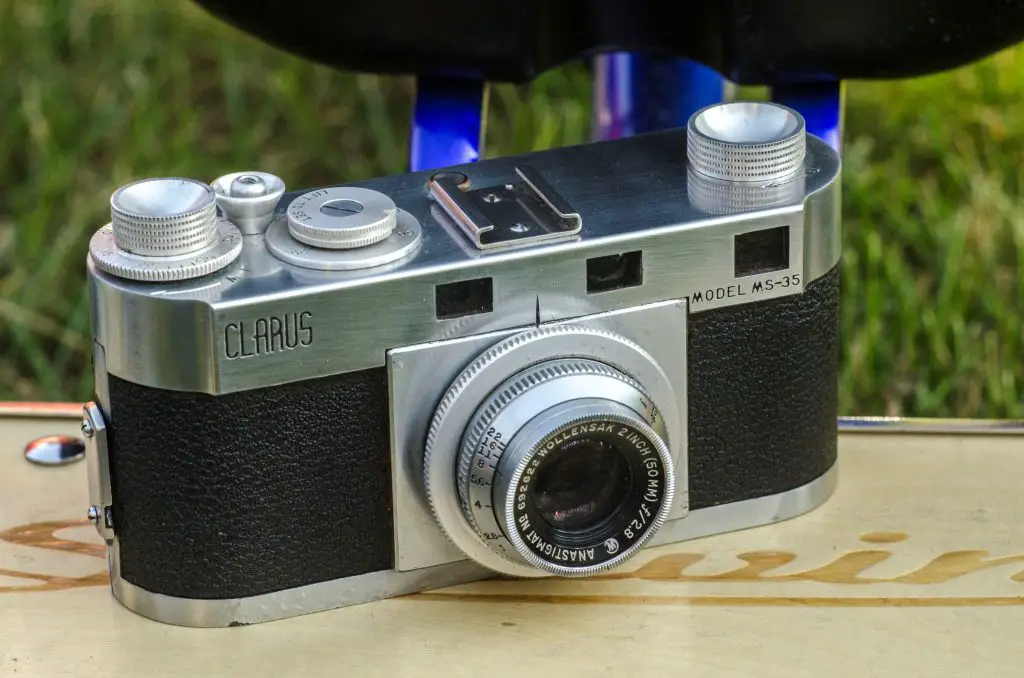 Film Type: 135 (35mm)
Film Type: 135 (35mm)
Lens: Wollensak 2 Inch (50mm) f/2.8 Anastigmat coated 3-elements
Lens Mount: Clarus Screw Mount (~41mm)
Focus: Coupled Rangefinder w/ separate viewfinder
Shutter: Focal Plane Cloth
Speeds: B, 1/25 – 1/1000 seconds
Exposure Meter: none
Battery: None
Flash Mount: Sheet metal cold shoe w/ proprietary flash sync port
Weight: xxxgrams
Manual: http://www.cameramanuals.org/pdf_files/clarus.pdf
My Final WordHow these ratings work |
The Clarus MS-35 is probably the biggest failure of any American made camera in the 20th century. Sure, there were other companies who failed, but the Clarus had a lot of things going for it. When it worked, it was a nicely designed camera capable of some really great shots. It looked good, and was comfortable too. Sadly, due to mismanagement of some sort within the company, it failed and represented the only model made by Clarus. I still think this camera’s fascinating history and good looks make it worthy of addition to any collection, but I really think it’s best if you don’t expect to shoot with it, as there’s a lot going against you. | ||||||
| Images | Handling | Features | Viewfinder | Feel & Beauty | History | Age | |
| 1 | 1 | 1 | 1 | 2 | 1 | 30% | |
| Bonus | none | ||||||
| Final Score | 9.1 | ||||||
History
Those 3 words accurately sum up the entire history of the Clarus Camera Manufacturing Company. Of all the cameras in my collection, this is the only one that represents the one and only model made by it’s company.
While there are a fair number of Clarus related articles online, most of them share the same information over and over. In a nutshell, after World War II, a Minneapolis based company called Clarus would release a 35mm rangefinder designed by a guy named Paul Mann.
The MS-35 was an ambitious camera that had many elements that should have made it a success. For one, it had a nice looking and very robust alloy metal body. The solid, all metal body of the camera is proudly proclaimed in the owners manual where it says:
The requirement of a successful 35mm camera is the ease of handling plus the need for rigid construction, without bulk or extruding gadgets.
The Clarus meets these requirements fully. It is carefully designed and balanced so as to handle easy. All controls are easily accessible. All parts are nearly styled and carefully arranged for ease and speed of operation. The body is constructed of three die-cast parts – front case, top case, and back. These parts form a one-piece camera with ample strength to meet the severest requirements.
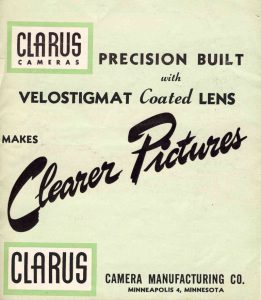 Durability and ergonomics were definitely a priority for the designers of the MS-35, and I’d have to agree that from a cosmetic standpoint, they did a pretty good job. Many of the period advertisements for the Clarus list that all controls are easily reachable from the top of the camera. Another “feature” of the camera mentioned in the user’s manual is that the body is clad in something called “war proven Redolite”. Whatever “Redolite” is, it obviously held up well as the example in my collection shows hardly any signs of wear and is not peeling. In fact, most of the Claruses I’ve seen come up for sale on eBay almost always show the body covering in as good of condition.
Durability and ergonomics were definitely a priority for the designers of the MS-35, and I’d have to agree that from a cosmetic standpoint, they did a pretty good job. Many of the period advertisements for the Clarus list that all controls are easily reachable from the top of the camera. Another “feature” of the camera mentioned in the user’s manual is that the body is clad in something called “war proven Redolite”. Whatever “Redolite” is, it obviously held up well as the example in my collection shows hardly any signs of wear and is not peeling. In fact, most of the Claruses I’ve seen come up for sale on eBay almost always show the body covering in as good of condition.
The first thing you notice when handling an MS-35 is how heavy and solid it feels. The body is a chrome plated metal alloy that generally retains it’s luster over the years. Most MS-35s I’ve seen usually keep their original shine, with the most common defect being some bubbling of the chrome plating. No plastic was used in the construction of the camera, like was common with many other cameras of the era. According to my wife’s kitchen scale, the Clarus MS-35 weighs 777 grams with lens attached, but no film. For comparison, a circa 1948 Argus C3 in my collection weighs in at 761 grams, and a circa 1951 Ihagee Exakta VX without lens attached, weighs 734 grams.
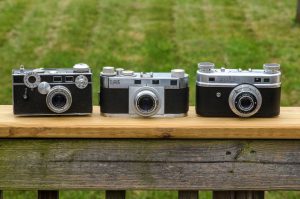
From top to bottom, the body is quite short. Shorter even than an Argus C3, but boy is it wide, and even more curious, is how thick the camera is front to back. An interesting post on rangefinderforum.com where a Clarus MS-35 is disassembled comments on how fat the camera is. The writer of the post finds the fatness of the camera to be peculiar because of how little there is inside of the camera. Clarus could have very easily made this camera smaller as it’s size does not appear to be the result of needing room for a large or complicated interior. In fact, a huge part of why the Clarus MS-35 failed was due to the overly-simplified shutter mechanism inside of the camera. It’s almost like the Clarus was supposed to have a more advanced shutter mechanism, requiring more room, but was scrapped in favor of a much more simplified design before the first models were ever finished. There is absolutely no evidence to support this however, its just a wild guess on my part.
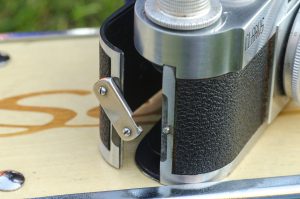
One very strange feature of the camera is the door latch. Unlike most cameras of the day that had some type of sliding latch, the Clarus has a rotating “bone” shaped piece of metal that has a notch which grips a small metal post in the door. Its kind of difficult to explain, so just look at the image to the left. While the latch does work in the sense that it keeps the door shut, it looks really out of place on the camera and seems like an afterthought. Strangely, earlier MS-35s had a more traditional sliding latch. For some reason, Clarus stopped using a sliding latch and replaced it with the kind seen here.
The rest of the camera looks like it was built for success, at least on paper. The dual rangefinder / viewfinder system was on par with other cameras of the day. In operation, the rangefinder is very similar to that of the Argus C3. If you’ve ever shot with a C3, then you’d know exactly what to expect. While I find these dual window cameras less pleasant to use than later “coincident” image rangefinders, they’re quite a bit easier to use than the tiny rangefinders like on the Kodak 35 RF, or the Soviet FED 2.
The camera cocks the shutter upon advancing the film and has double exposure prevention. Later models came equipped with a strange flash sync port on top of the camera. I have found no info about what type of port it is, as it does not look like any other flash sync port I’ve seen, but then again, I don’t pay much attention to vintage flashes.
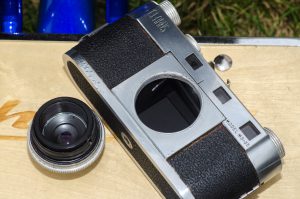
Finally, the camera had it’s own unique Clarus interchangeable lens mount. Rather than go with a universal 39mm mount like Leitz and other German manufacturers were using, Clarus chose a proprietary mount, just like most other American camera manufacturers of the day. Argus, Perfex, Detrola, and Universal (Univex) are all examples of 1940s American manufacturers who had proprietary interchangeable lens mount cameras.
Edit: The reason Clarus did not share the Leica’s 39mm mount was that prior to the war, Leica had a patent on the design of the “Leica Mount” and other companies couldn’t use it. This explains why pretty much any screw mount camera prior to the war did not share the 39mm screw mount. This patent expired after the war, but most likely Clarus decided to stick with their own mount to honor that original patent.
In a post on photo.net, JDM von Weinberg measured the Clarus mount and found it to be slightly larger than 41mm in diameter. He says that a 40mm Praktiflex lens is too small, and a 42mm SLR lens was too big. He hypothesizes that the lens mount might have been in inches, a measurement still common in post-WWII United States. If so, the lens mount could have been 1 5/8″ (~41.27mm). This is supported by the MS-35’s manual, which says the camera has a flange focal distance of 1.509 inches, plus the Wollensak lens shows it’s focal length as 2 inches. This continued use of the American Imperial system, instead of the metric system certainly supports Mr. Weinberg’s theory.

Despite the limitation of a unique lens mount, there were at least 5 different lenses available upon it’s release. They were:
- Wollensak 2 inch (50mm) f/2.8 Velostigmat/Anastigmat (the most common)
- Wollensak 2 inch Raptar f/2 Anastigmat
- Wollensak 35mm Raptar f/3.5 Wide Angle
- Wollensak 101mm f/3.5 Telephoto
- Elgeet 4 Inch f/4.5 Telephoto

I would imagine that had the MS-35 been a greater success, more lenses would have been developed for it. The original user’s manual has a page that suggests that additional lenses and accessories would be available, but that you would need to write to the company for more information. It is unclear as to whether or not more lenses were actually developed.
So far, it seems the Clarus MS-35 was a nice looking American made 35mm rangefinder with a decent selection of lenses and a very sturdy body. So, what went wrong?
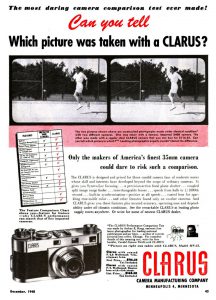
Before I answer that question, it’s worth talking about what the market for an American built 35mm rangefinder with promises of European quality and features would have been like in 1946. Prior to World War II, most of the world’s best cameras were made in Germany. Once war broke out, getting anything exported out of Germany was quite difficult. As the war raged on, the appetite for high quality photographic equipment was growing in countries like the United States. Sure, we had our own models like those made by Argus, Universal, and Kodak, but there wasn’t anything even remotely close to what the German’s had with their Leicas, Contaxes, and Rolleis.
To make matters worse, once the United States entered the war, a large majority of our manufacturing capabilities became focused on making things for the war effort. Camera production was not an essential war-time product, so for the people still back at home who might have wanted a camera, their options were limited.
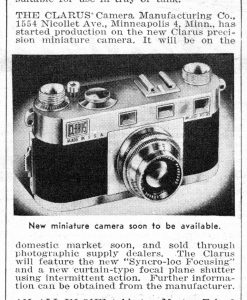
When the war ended and thousands of troops came back home, there was a large priority on returning life back to normal and doing “normal” things like taking pictures. People had money, and they wanted to spend it. That, combined with a huge amount of American patriotism, there was an enormous appetite for any kind of American made product.
Clarus would announce it’s new camera in the June 1946 issue of Popular Photography proclaiming that an all-new miniature camera would soon become available with “Synchro-loc” focusing, and an all new curtain-type focal plane shutter with intermittent action (whatever that means).
In all of the advertisements that I saw for the Clarus, the big selling point was the camera’s value. Yes, it’s list price was substantially lower than the European cameras (Leica) that the Clarus claimed to be able to compete with, but it was still a fairly significant investment for a working class family.
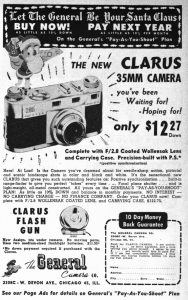
The ad to the right appeared in the December 1947 issue of Popular Photography and shows the list price with a Wollensak f/2.8 lens to be $122.75. When adjusted for inflation, that’s like $1300 today. Other ads from around the same time show the Clarus with the top of the line Wollensak Raptar f/2 lens to be $168.50 which is like $1700 today.
Upon it’s release, people must have been pretty excited. Sure, the camera was quite a bit more expensive than other American cameras like the Argus C3 or the Perfex, but here was an all new design with a cloth focal plane shutter capable of speeds as fast as 1/1000 with an interchangeable lens mount just like the Europeans had.
All was not well however, as the earliest Clarus cameras quickly started to reveal the camera’s shortcomings. Many Clarus cameras had inconsistent shutters from the very beginning. I don’t know that we’ll ever know what went wrong with the early design of such a promising camera, but perhaps the best guess is that this was an ambitious new design by a company who had no experience making cameras. Clarus pretty much appeared out of thin air, unlike other companies like Argus or Kodak who already had success making other products before making their first camera.
The hype of an advanced American built 35mm rangefinder that could compete with European models quickly turned to disappointment after the model became available. It’s substantial price tag would have also turned off buyers who would have expected that for the price, they were buying a camera that functioned as intended.

The most common complaint about the camera is it’s shutter. The focal plane design uses a 4 drum system similar to those used in Ihagee Exakta and Wirgin Edixa SLRs. This type of system should have allowed for the shutter speeds to be changed before or after cocking the shutter, but strangely in the Clarus, the camera displays the incorrect speed until after advancing the film and cocking the shutter. You can still change the speeds before or after cocking the shutter with no ill effects, you just won’t know what speed you’ve selected until after cocking it.
Another peculiar design choice for the shutter was that unlike most other cloth focal plane shutters, the shutter itself does not use ribbons. Instead, both the front and rear curtains are single pieces of shutter fabric, with large notches cut out leaving strips of fabric in place of actual ribbons. While an effective method of reducing the cost to manufacture the camera, it was no doubt a contributing factor of the inconsistent and unreliable nature of the Clarus’ shutter. On the plus side, the cloth curtain is coated on both sides with a durable rubber coating that at least on my example looks great, nearly 70 years after it was made.
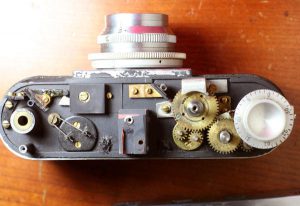
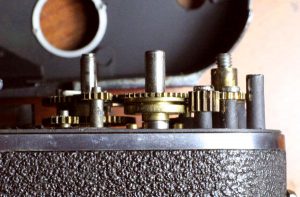
Despite these cost-cutting choices in design, the rest of the shutter was fundamentally sound. One of the most respected sources of information regarding vintage cameras is Rick Oleson, and on his page for the Clarus, he describes the shutter in the MS-35 as not having anything fundamentally wrong with it. He suggests that the fault in the shutter was more due to materials and low manufacturing tolerances than anything else. The shutter gears, bushings, and bearings are all machined out of brass. The shutter spindles are thick and have an appearance of robustness. What little is inside of the shutter looks to be well made and as strong and robust as the outward appearance of the body suggests.
During the entire production run of the MS-35, Clarus made several design revisions to the model. Scott Bilotta’s Photographica Collection’s website has a pretty in depth list of all of the changes to the camera throughout it’s run. I won’t duplicate the information he already has, but it would seem that the example in my collection is a later model as it has the sheet metal cold shoe, notched speed dial, and is missing strap lugs. For anyone attempting to identify the year their Clarus was manufactured by it’s serial number, it would seem that the numbers used on the body and lens had no relevance to production order.
In my research for the Clarus, the only reference to production numbers is on the MS-35’s Camerapedia page which suggests that 20,000 were made between 1946 and 1948. If true, its possible that less than 30,000 or so would have been made since the camera’s poor reputation by 1948 would have undoubtedly hurt sales. Whether this guess is correct or way off, it would seem that quite a few were sold during their 6 year production run as they are still relatively easy to find today. As I write this, a quick eBay search returned 11 of them for sale. While 11 is certainly not a high number, anyone reading this article could go out at any time and pick one up. It should also be noted that after 1952, the design of the Clarus was sold to a Chicago company called Wescon who released a number of Wescon branded cameras that looked nearly identical to the Clarus, except they had a leaf shutter mounted to the lens, in lieu of the problematic focal plane shutter.
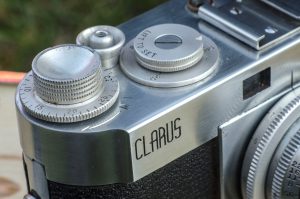
It’s easy to dismiss the Clarus MS-35 as a complete failure due to its fat body and unreliable shutter, but during my research for this model, I searched Google’s Books archive for old issues of Popular Photography from 1946 – 1949 and I could not find one piece of negative press about the camera. Everything I’ve read about how bad this camera was is from modern articles. Certainly Google Books is not a complete representation of every photography article or review of the past century, but the fact that I could not find a single piece of negative press from back then at least suggests that perhaps people’s opinion of the camera wasn’t as bad as is often thought.
Today, the Clarus MS-35 seems to be an anomaly of American camera design. As a general rule, the Argus C-series has it’s dedicated collectors, and there are those who specifically collect Kodak cameras, but otherwise, most other American cameras typically go unnoticed. I see Clarus cameras on eBay quite often, and the prices are all over the place. Some of the rougher looking ones can sell for under $20, but then the occasional nice one will approach $100. Knowing the Clarus’ reputation for bad shutters, I wanted to wait until a nice one came along that had some statement of condition, and I finally picked this one up for under $20.
The MS-35 has a fascinating history, and had it been successful, could have been a highlight in the history of American photographic production, but of course, it didn’t. Still, this is a handsome camera, and despite it’s shortcomings, I think that if you can find one in good enough condition, and are willing to work within it’s capabilities, you could still get some great photographs out of one.
My Thoughts
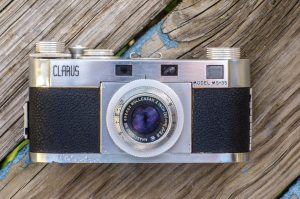
I can’t remember the first time I saw a Clarus because I remember always liking them. I had known for quite some time the reputation of the Clarus shutter and that for as pretty as they are, the likelihood that I would get one in working condition was slim.
So, when one finally fell into my lap, I was on pins and needles waiting for the camera to arrive. The seller’s description of the camera was that the shutter did fire, but the slow speeds were off. What was ‘off’? Just a little slow, or would it not fire at all? I am certainly no stranger to cameras with unusable slow speeds, but if 1/100 and higher are OK, you can generally shoot 200 or 400 speed film outdoors with no problem.
Upon receiving the camera, it was both better and worse than I expected. For starters, the camera was in beautiful condition. Despite how it looks in pictures, the body of the Clarus is not solid aluminum like a Univex Mercury. This is a die-cast metal camera with a chrome plating that has a brushed look added to it. The most common conditional issue with the body of Claruses are that the chrome plating can start to bubble and peel off. Mine does show some signs of this, especially on the back and bottom, but it’s certainly not bad.
The “war proven Redolite” looked great and was not peeling. I still don’t know what “Redolite” is, but it has a plasticky feel not unlike the cheaper body coverings of some 60s and 70s SLRs. It’s nowhere near as nice as genuine leather, but it also doesn’t show signs of aging like most leather does.
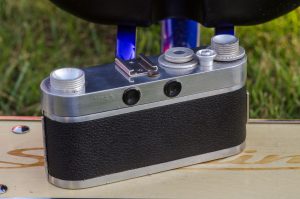
The rangefinder seemed to be spot on accurate. A quick “telephone pole” test at infinity lined up perfectly. The glass elements of the lens were in great shape with no obvious signs of haze, fungus, or major scratches. All of the motions of the lens were smooth and free of grit or other signs of “sticky goo” like what plagues many other mid century lenses.
A strange characteristic of the rangefinder is that the camera’s lens does go beyond infinity, pushing the rangefinder beyond it’s limits. I found that the camera was accurate at infinity, but you cannot trust that it stops at infinity. Turning the focus ring as far as it can go, will give you out of focus shots.
The shutter curtains themselves seemed to be in very nice shape. I did a quick “flashlight” test of the first and second curtains of the shutter and saw no obvious pinholes or tears.
So far so good, right? Well, the downside is that the issues with the shutter seemed to be a bit worse than “the slow speeds are off”. A better description of the shutter speeds are that all speeds, from 1/25 – 1/1000 open and close at seemingly random intervals. Many times, the shutter acts like it’s in “Bulb” mode, staying open for as long as I hold the shutter release down, regardless of what speed was selected.
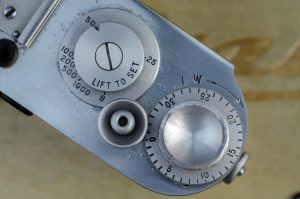
I persisted firing the shutter over and over and noticed that things started to improve with repeated use. It got to a point where 1/100 seemed to be the most well behaved speed. I also noticed a strange phenomenon where if I ever so slowly pressed down the shutter release, the speeds would often work correctly. If I pressed the shutter release too quickly, or with too much force, the chances it would get stuck in “Bulb” mode went up.
I figured at this point, I was already tempting fate by simply looking at the camera, and I was afraid that any attempt to do any kind of work on the camera would result in disastrous consequences, so I made a managerial decision to just load film into the camera as is, and see what I would get. I decided that when it came time to shoot with the camera, I would keep the shutter at a constant 1/100, and only adjust aperture to give myself the best chance at properly exposed images.
Edit 3/23/2017: I decided to take a shot at cleaning and lubing the Clarus to see if I could improve the shutter reliability. I will add a whole new Review section to this review below with some details on how it went.
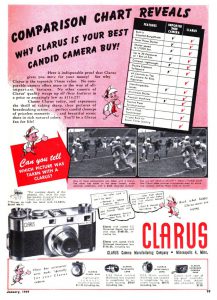
Shooting with the Clarus was a joy. The good looks of this camera translate extremely well to a pleasant shooting experience. Many of Clarus’ advertisements championed the thoughtful design of the camera’s controls compared to an unnamed $400 import. Everything is easily accessible either on the lens barrel or on top of the camera.
The viewfinder is surprisingly effective considering its age and size. I don’t know if this was intentional, but the dual rangefinder and viewfinder windows are nearly identical to those found in the Argus C3. Size, coverage, and magnification are almost exactly the same. I had no problems using either window wearing prescription glasses. I’d say the only difference between the two was that the rangefinder window lacked the blue or yellow coloring found in most C3s.
The MS-35 is heavy, and is quite wide, but I never found it’s size or weight to be obtrusive. The thickness of the body nearly fit my hands perfectly. I am an average sized male, with average sized male hands, and I was very comfortable using this camera. None of the controls required repositioning of my fingers, and all of the essential controls were exactly where I expected them to be. Comparing this camera to other American cameras from the 40s and 50s like the Argus C3 or Kodak Signet 35, the ergonomics are better.
These facts emphasize what a missed opportunity the Clarus MS-35 represented. There was an enormous appetite for a quality American made camera right after World War II. The MS-35 looked great, had great ergonomics, a good lens, and on paper, had all of the features anyone would expect at the time. It’s just such a terrible shame that the reliability of the shutter was so poor. We can only speculate at what exactly went wrong with Clarus as a company, but the lack of experience and mismanagement must be the explanation for this camera’s woes.
Still, enough were sold that it’s not hard to come across one today, and I was very pleased to get the opportunity to shoot with this one. I realize that at any moment, the shutter could completely seize and stop working altogether, but for as long as I can get this shutter to fire, even at one speed, I will continue to shoot with it.
Repairs – Added 3/23/2017
In the months that followed the initial roll of film that I used to write this review, I decided it was worth a shot to disassemble the Clarus and see if I could resolve the shutter issue. After all, I’ve had success with other American made post-war cameras like the Argus C3 and Ciro Flex. The Clarus body seemed to be pretty straight forward, so I got out my Wiha precision screwdrivers and started disassembling. Looking back, taking apart this camera is quite easy. I can show you all of the parts in one single picture.
The image to the left shows every single screw, knob, and dial that needs to be removed to lift off the top plate. You need nothing more than a screwdriver and your fingers to get the top plate off. Not shown in the picture is a small spring beneath the shutter speed dial (E) that needs to be saved, and a couple of spacers beneath the shutter release button (F). I always recommend taking a photo of a camera with a digital camera or smartphone at each step of disassembly, and this is no different. Even with my instruction, you should always take your own pictures as a precaution. Remember that the Clarus went through many minor revisions in it’s life, so theres no telling what kinds of surprises might be inside.
The image to the right shows what’s under the top plate. You can actually see some of the spacers here, especially the ones under the shutter release. Notice that the gears making up the shutter release mechanism are quite dirty. This was part of the reason the shutter on my camera was so inconsistent. I took an old toothbrush and dipped it in some naphtha oil and cleaned the gears as best as I could. Once the gears were clean, I used a couple of drops of machine oil to lubricate all moving points and in all the spots where the gears meshed together. To avoid using too much oil, I absorbed excess oil using Q-tips wherever necessary.
When cleaning and lubing the camera, it is necessary to fire the shutter several dozen times to get things moving so the oil can soak in where it needs to. In order to do this, you need to temporarily put the winding knob, and the shutter speed dial back in place. The winding knob simply screws back into position and the shutter speed dial rests over the large gear where the letter “E” is in the first image in this section. I made a Youtube video below which shows the shutter in action, which will show you where these two knobs need to be.
Once you work in the lube and get the gears as clean as you can make then, hopefully you’ll start to see some improvement with the shutter. I noticed that the entire cocking and shutter release processes were smoother and met with less resistance. The shutter began to work at all speeds from 1/1000 to 1/25. To my ears, it sounded like 1/250, 1/500, and 1/1000 were all the same, but at least they worked.
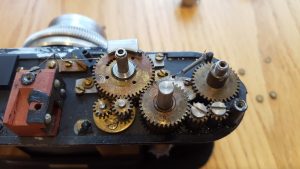
 With the shutter clean and lubed, here are two images to the left and right showing everything right before putting it all back together. You’ll notice that the brass gears still show quite a bit of oxidation, but at least they’re clean.
With the shutter clean and lubed, here are two images to the left and right showing everything right before putting it all back together. You’ll notice that the brass gears still show quite a bit of oxidation, but at least they’re clean.
With the top plate off, you can also clean the two mirrors that make up the rangefinder, and all glass windows on the viewfinders. Doing this improved the clarity and brightness of both viewfinder and rangefinder windows dramatically.
By the time I was done, with clean mirrors, viewfinder glass, and a properly lubed shutter mechanism, the Clarus MS-35 felt like an entirely new camera. I actually felt a sense of confidence playing with it, rather than the ticking time bomb I felt during my inaugural roll of film. I now agree with Rick Oleson’s initial assessment that there is nothing fundamentally wrong with the design of the Clarus’s shutter, but it’s the inconsistent build quality that doomed them.
Check out this Youtube video I made of the shutter in action. You’ll see me cock and fire the shutter at various speeds including Bulb. Although I do not speak during this video, I typed up subtitles that you must manually turn on, which explain everything that is happening. I have found that subtitles work better in Youtube videos using a PC, rather than a smartphone, but it should work regardless of how you watch it.
My Results
Most of the shots from the Clarus were shot on my birthday when I took a day off work to visit Parke County, Indiana, near Turkey Run State Park. The whole area is filled with a large number of covered bridges, creeks, hills, and the state park itself has some of the best hiking trails in the Midwest.

On this trip, I brought a grand total of 12 cameras to shoot which turned out to be a huge mistake, but that’s a discussion for another post. One of the many reasons this was a bad idea was that I loaded all of my gear into a suitcase, which I put in my car’s trunk the night before. That night, temps dropped into the low 40s, and upon reaching the state park, everything in the trunk was still extremely cold. Thankfully, I hadn’t yet loaded film into the Clarus yet, so I had one last chance to check that everything was working properly, which it wasn’t. Unlike my testing the day before, all shutter speeds acted like Bulb and would stay open for as long as I held the shutter release down. Upon releasing the shutter release, the second curtain would close very slowly.
Nearly devastated that my MS-35 had failed me upon the verge of getting to shoot with it, my only theory had to do with how ice cold the camera was, sitting overnight in my trunk. Perhaps the cold had thickened what little lubrication remained in the camera after all these years. So as a last ditch effort, I cranked the heat up in my car, turned on the floor vents and put the camera in the direct path of my car’s heater for about half an hour.
Turns out that did the trick because once I got the camera nice and warmed up, the shutter began to work as it had the previous day. It was still extremely inconsistent at either of the slowest or fastest speeds, but 1/100 seemed to be the least inconsistent. So, I loaded in a roll of Fuji 200 and used sunny 16 with a 1 stop correction.
I expected the worst and hoped for the best, and when I got the scans back, I was pleased to see that I got somewhere in between.
Starting with the good, my assumption of shooting 1/100 with a 1 stop correction on Fuji 200 seemed to be a good idea as most of the shots are exposed correctly, even my attempts at shooting the camera indoors and in low light.
The rangefinder is accurate. The image of the three glasses and the child with the cell phone are at, or very near minimum focus. The child on a bike is about 10 feet away from me, as are the license plates. The rest are at infinity. I’d say every single shot from the camera was accurately focused.
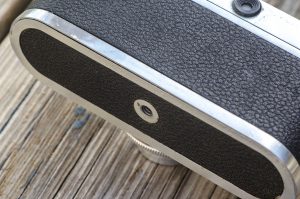
The sharpness of the Wollensak 2 inch lens is impressive. People often talk about how good the Argus Cintar is, and I’d say this lens is every bit as good, maybe even better with it’s maximum f/2.8 aperture. The corners are a tad soft, but nothing that’s immediately noticeable and absolutely consistent with other lenses of the era. It is very clear that the Clarus was not designed as a low-spec camera. It was aimed at the mid level market, and when it works, it absolutely hits it’s target.
The glaring fault however, which was expected all along, was the shutter. About half of the roll had light leaks galore. While it’s possible these came from the film compartment, their consistency seems to suggest that the shutter stayed open a tad too long before closing. Most of the light leaks are white, suggesting it came from the lens, and not the rear of the camera.
In hindsight, I should have taken more steps to protect the film compartment from light, as its possible some electrical tape around the door seal would have eliminated this, but I won’t know until I shoot another roll.
After this first roll, I can’t help but be a little sad at what could have been. There are bits and pieces of the Clarus MS-35 that were very well done. It was clear, that at least someone at that company had a good idea of what should go into an American made rangefinder. When the camera worked, it produced some really great shots. I really enjoyed my time with the camera and it’s ergonomics fit my hand quite well. Had a little more time been spent on some small details like the door hinge and rangefinder that goes beyond infinity, and the camera included a better designed shutter, this would have been a winner, and who knows what Clarus might have come up with next.
Related Posts You Might Enjoy
External Links
http://rick_oleson.tripod.com/index-110.html
http://www.vintagephoto.tv/clarus.shtml
http://camerapedia.wikia.com/wiki/Clarus_Model_MS-35
http://www.rangefinderforum.com/forums/showthread.php?t=139086
http://www.novacon.com.br/odditycameras/clarus.htm

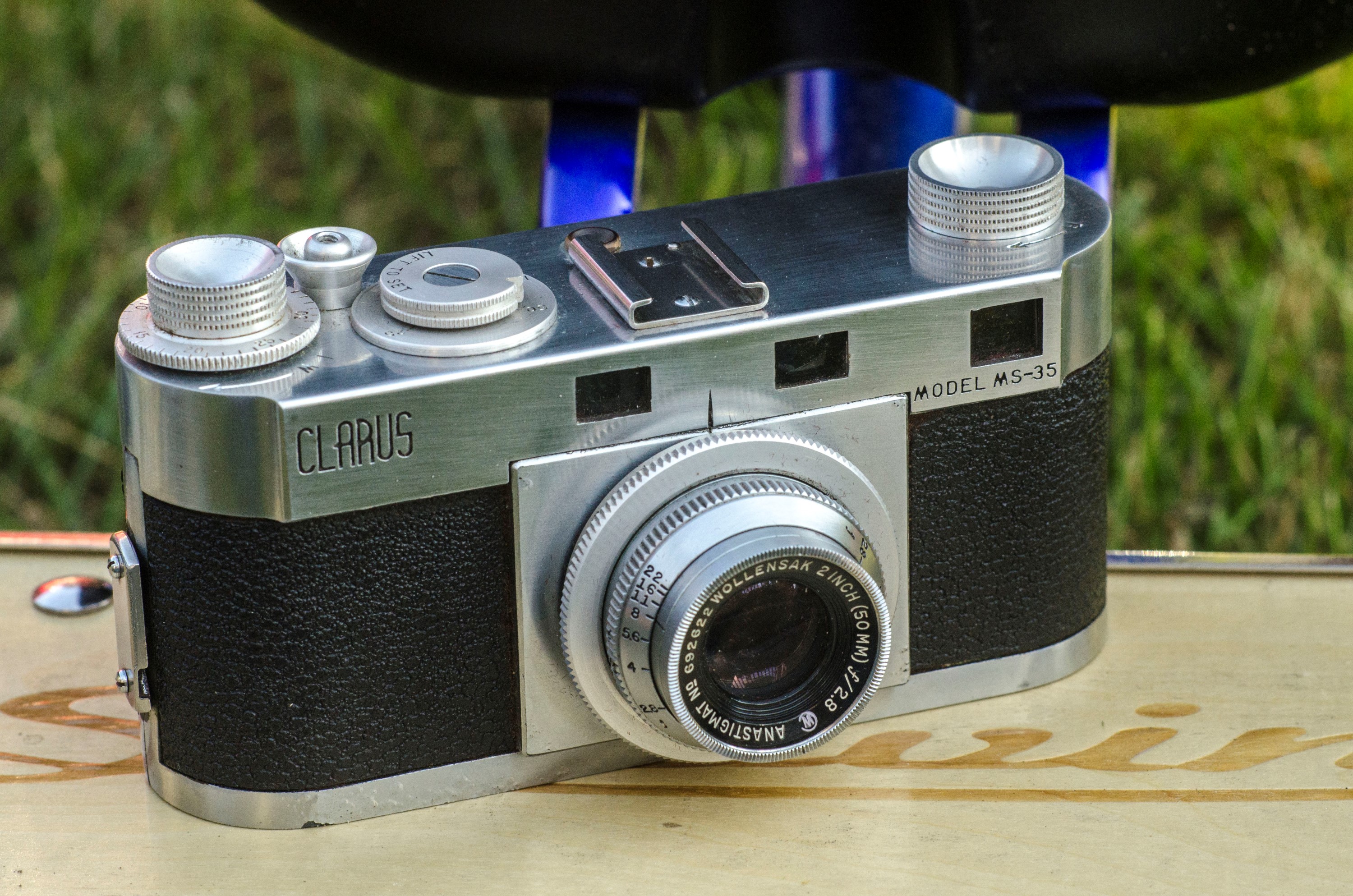
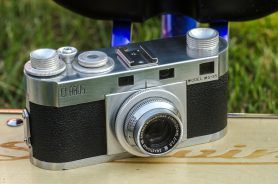
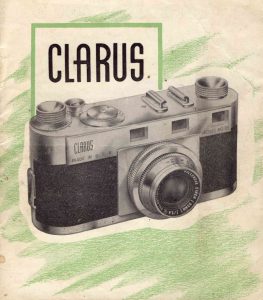
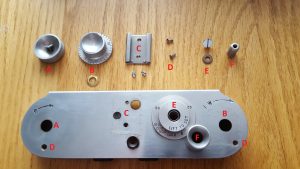
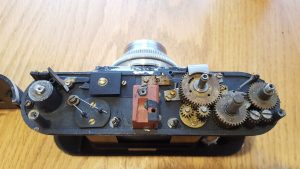








Hello, good sir. Reading this post inspired me to bring out my Clarus and give another go of repairing it. 1 out of 4 cycles of the shutter would result in both curtains traveling together, even in bulb setting. I found the problem to be the delay pawl. This must be absolutely free to move. I loosened the screw just a fraction of a turn and made sure the post was good and oiled. Since then, I have been relentlessly cycling the shutter in all speeds and it hasn’t skipped a beat, even after sitting overnight. You might try it if you’re still having inconsistencies. I love your site and always come back for a read.
Thanks and regards,
Kevin.
A few months ago, I’d never heard of a Clarus….even though I lived in Minneapolis for many years. I even know where the office/factory is/was.
Now have two of them thanks to you….. my first one has the usual slow shutter at any speed, although I felt grateful that it worked at all. My second one, while, I haven’t tested the timing, seems to work fine at all speeds…..yippee! So I will test with film soon.
I am in love with the aesthetics, and build quality, for sure…..one of my favorites.
I will take my first one apart and do a CLA, and see what happens!?
Thanks as ever for your fine reviews….they are my first, go-to, when I need good info…..Thanks!
Picked up a Clarus 35 yesterday at a flea market.
Until then I thought that I’ve seen everything. It’s OK. Agree with your assessment. Debating giving it your cleanup.
Lens focus ring is stuck. Tried removing the stages, but I cannot get the little screws back in.
It reminds me of a Univex CC: postwar, limited life cmpany
Clarus 35 was one ff ny first “colect-camera” Bought in the early seventies